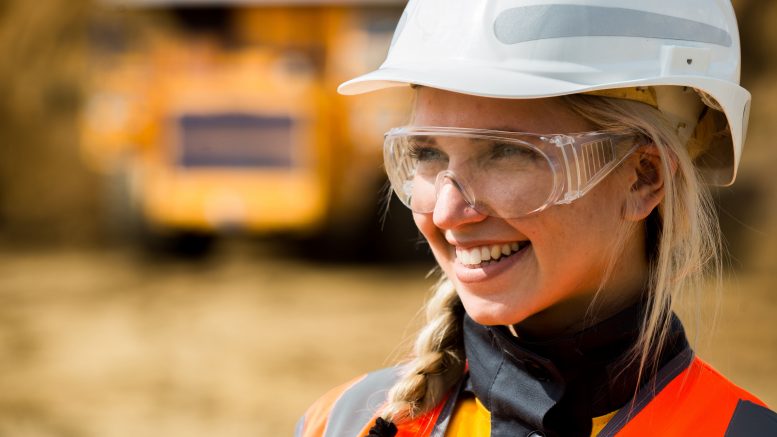VANCOUVER — Accounting and management consulting firm EY has joined forces with Women in Mining (WIM) UK to produce a report entitled “Has mining discovered its next great resource?” The report delves into the principles and actions that organizations can adopt to support and retain women in the workforce.
According to 2015 research from the Mining Industry Human Resources Council, women account for 17% of mining sector workers in Canada. Most women work in clerical and corporate service jobs in mining, with female workers holding only 4% of most trade and production roles.
EY has found that the number of women in management roles is also relatively low: out of the world’s top-30 mining and metals companies, only 35 directors out of 377, or 9%, are women.
EY and WIM presented their results at a downtown Vancouver convention centre. During an ensuing panel session, the question was raised whether it’s mainly women discussing the issue of gender equality in mining.
“We’re assuming that men aren’t having these conversations,” Nicole Adshead-Bell, president of Cupel Advisory and director of Lithium Americas (TSX: LAC), Dalradian Resources (TSX: DNA; US-OTC: DRLDF) and Pretium Resources (TSX: PVG; NYSE: PVG) told the audience. “We’re also assuming that women are supportive of other women and that’s not necessarily the case. Men don’t wake up every morning thinking to themselves how they’re going to subjugate women today. There isn’t an active intent … but there are inherent biases that affect both females and males. All we can do, as reasonable human beings, is try to be aware of gender bias and counteract those behaviours when they arise.”

Nicole Adshead-Bell during a site visit at B2 Gold’s Otijikoto gold deposit in Namibia. Credit: Nicole Adshead-Bell.
Adshead-Bell noted that rules introduced in 2015 require a TSX-listed company to disclose annually the number of women on its board, and whether the company has a policy or intention to nominate women directors or officers — among other related information.
But the main barriers that prevent women from reaching the board level, the EY-WIM report argues, are a lack of females in the talent pipeline, and a tendency of women to undervalue and under-promote themselves.
Adshead-Bell and others on the panel agreed that low “self-efficacy” — the ability to believe in one’s ability to succeed at a task — is prevalent amongst females and could be a subtle behavioural disorder that starts at an early age.
“In Australia, kids are asked between grades one and 10 how good they are at something, and the boys often respond that they’re better than they are, whereas female children say they’re worse than they are,” Adshead-Bell said. “There are so many statistics that show women are less willing to take credit for something, to use the word ‘I’ and are less active in negotiating. So women are essentially forced to adjust their behaviour if they want to advance their careers.”
Work-family balance is also a major factor, Adshead-Bell said.
“Women are still the primary caregivers … and I imagine it’s difficult to balance a family while having a demanding career, where in today’s world means you need to be on call 24 hours a day,” she said. “Most women are forced to make a choice — the exception being that they have a partner who is more involved in the childcare situation, or they have a job where they earn an unusually large amount of money to afford adequate child care.”

A group of women geologists, first-aid respondents, core technicians and core cutters at Barkerville Gold Mines’ Cariboo gold project in south-central B.C. gather to celebrate International Women’s Day on March 8. Credit: Andrew Ganton.
Dean Winsor, Teck Resources’ (TSX: TCK.B; NYSE: TECK) vice-president of human resources and chairperson of Teck’s senior executive diversity committee, said the work-family balance issue doesn’t affect women alone.
“A lot of younger men absolutely want to take advantage of being closer to the family, and there’s a growing need for people to balance work with their personal lives,” he said. “If you make a workforce that’s better for women, you’ll make it better for everyone.”
Nearly half of those working in mining today are over 45 years of age, and as they near retirement, the pressure is on to fill their positions.
Several major mining companies — Vale (NYSE: VALE), Anglo American (US-OTC: AAUK; LON: AAL), Goldcorp (TSX: G; NYSE: GG), Rio Tinto (NYSE: RIO; LON: RIO) and Teck — are making efforts to better tap into their female talent pools, and details of their respective programs are highlighted in the EY-WIM report.
Most of these programs focus on sponsorship and pairing women with mentors, in an effort to offset what is called the “majority advantage” that men may benefit from in a male-dominated mining industry. This majority advantage arguably gives men access to more “natural mentoring,” as well as inside information and valuable contacts that, in turn, accelerate their careers.
Adshead-Bell — who has a PhD in structural and economic geology, and worked as a boots-on-the-ground geologist before moving into executive and financial roles — recalled forging her relationships in the junior exploration subsector in the “natural” way.
“When I review my career, I’ve never had an obvious mentor nor sponsor, and when I polled my predominantly male peers they provided a similar response. My conclusion is that you cannot rely on someone else to stickhandle your career, whether you’re a man or a woman. It’s crucial to build a broad network through connecting with multiple participants active in all sectors of the exploration and mining industries. When building your network — which should be a lifelong endeavour — be genuine, sincere and humble. Network building is one of the most enjoyable and expeditious ways to add to your knowledge base, plus the old adage ‘it’s not what you know, it’s who you know’ will always be crucial in career advancement.”


Be the first to comment on "How to encourage women to work in mining"